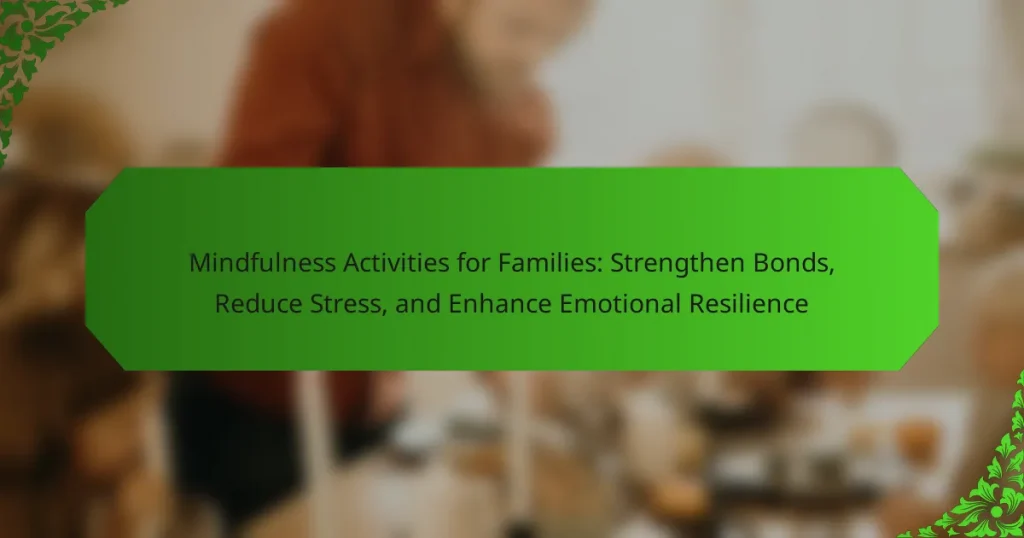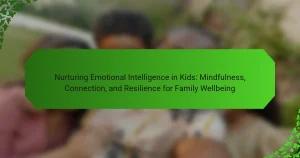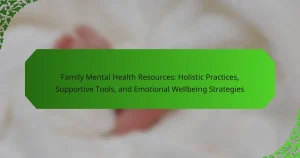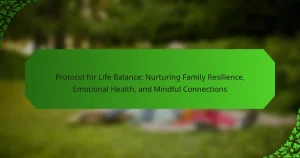Mindfulness activities for families can strengthen bonds, reduce stress, and enhance emotional resilience. Engaging in practices like group meditation, nature walks, and mindful cooking fosters communication. Families can also explore unique activities such as forest bathing and art therapy for deeper connections. Establishing a consistent routine and setting clear intentions further supports family mindfulness efforts.
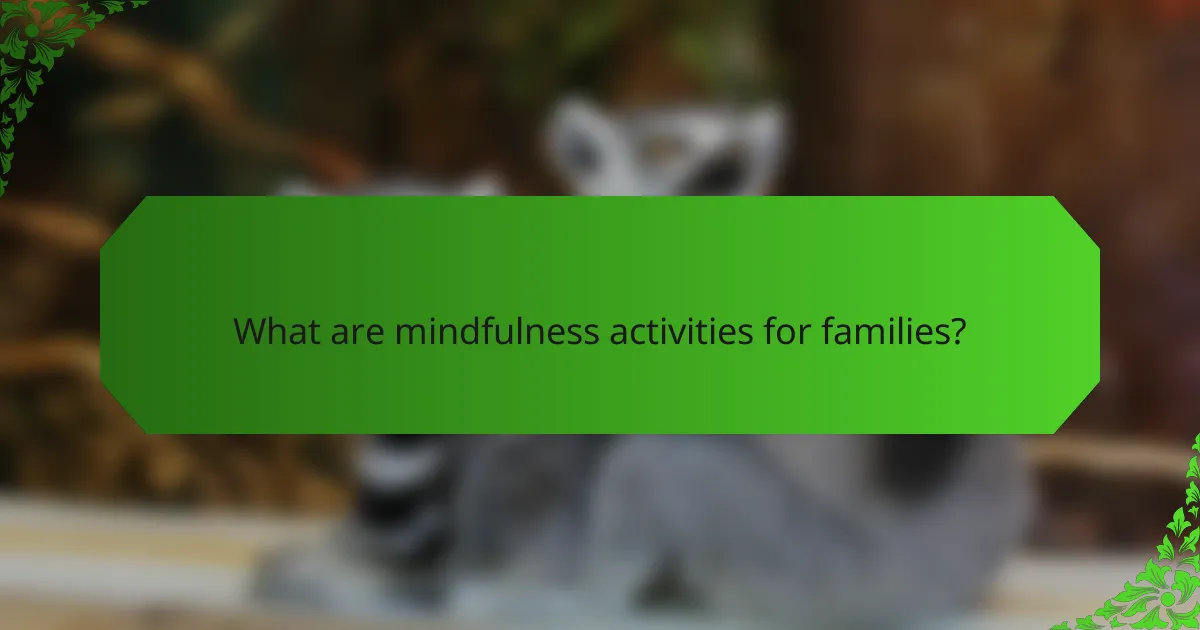
What are mindfulness activities for families?
Mindfulness activities for families include practices that promote connection and emotional well-being. These activities strengthen bonds, reduce stress, and enhance emotional resilience. Engaging in group meditation, nature walks, and mindful cooking fosters communication and understanding. Research shows that families practicing mindfulness report improved relationships and reduced anxiety. Incorporating these activities regularly can lead to lasting benefits for family dynamics.
How do mindfulness activities strengthen family bonds?
Mindfulness activities strengthen family bonds by fostering communication, enhancing emotional connection, and reducing stress. Engaging in shared mindfulness practices, such as meditation or yoga, encourages families to be present with one another, promoting empathy and understanding. As a result, families experience improved emotional resilience, allowing them to navigate challenges together more effectively. Research shows that families who practice mindfulness report higher satisfaction in relationships, illustrating the unique impact of these activities on familial ties.
What stress-reducing benefits do mindfulness activities offer?
Mindfulness activities significantly reduce stress by promoting relaxation, enhancing emotional awareness, and improving overall well-being. Engaging in practices like meditation and deep breathing helps families manage anxiety and cultivate resilience. Studies show that regular mindfulness practice lowers cortisol levels, leading to decreased stress responses. Additionally, these activities foster stronger family bonds, creating a supportive environment that further alleviates stress.
How can mindfulness enhance emotional resilience in families?
Mindfulness enhances emotional resilience in families by fostering connection and reducing stress. Engaging in mindfulness activities, such as meditation and deep breathing, helps family members manage emotions effectively. Research indicates that families practicing mindfulness report improved communication and stronger relationships. These activities create a supportive environment, allowing individuals to express feelings and cope with challenges together. By integrating mindfulness into daily routines, families can build lasting emotional strength and resilience.
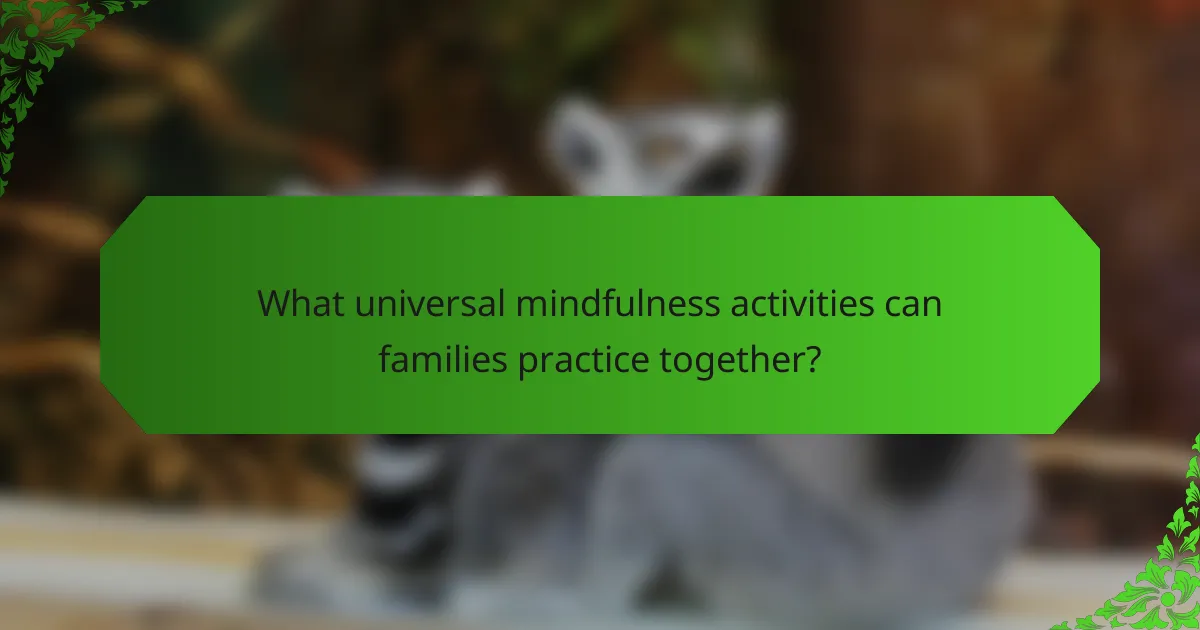
What universal mindfulness activities can families practice together?
Families can practice various universal mindfulness activities together, enhancing their emotional resilience and reducing stress. Engaging in these activities fosters deeper connections among family members.
One effective activity is mindful breathing, where families take time to focus on their breath together. This practice promotes relaxation and helps manage anxiety. Another activity is nature walks, allowing families to connect with the environment while being present in the moment. Guided meditation sessions can also be beneficial, as they provide a structured way to cultivate mindfulness collectively.
Journaling as a family encourages reflection and sharing of feelings, strengthening emotional bonds. Additionally, practicing gratitude by sharing three things they are thankful for each day can enhance positivity within the family unit. These activities create a supportive atmosphere, essential for nurturing mental well-being.
What are some simple mindfulness exercises for children?
Mindfulness exercises for children include simple activities that promote focus and emotional awareness. Breathing exercises, such as deep belly breathing, help children center themselves. Guided imagery can enhance creativity and relaxation by encouraging visualization of peaceful places. Body scans teach awareness of physical sensations, fostering connection with emotions. Mindful walking encourages observation of surroundings, enhancing presence. These activities strengthen family bonds while reducing stress and enhancing emotional resilience.
How can family yoga sessions promote mindfulness?
Family yoga sessions promote mindfulness by fostering connection, reducing stress, and enhancing emotional resilience. Engaging in yoga together allows families to practice presence, deepen communication, and cultivate empathy. Research indicates that regular family yoga can lower anxiety levels and improve overall well-being, making it a unique attribute of mindfulness activities. By incorporating breathing techniques and meditation, families can strengthen their bonds and create a supportive environment for emotional growth.
What role does mindful breathing play in family activities?
Mindful breathing enhances family activities by promoting relaxation and emotional connection. It fosters a calm environment, allowing family members to communicate openly. Engaging in mindful breathing exercises together can reduce stress levels, making interactions more meaningful. This practice strengthens bonds, as families share moments of presence and awareness, leading to improved emotional resilience.
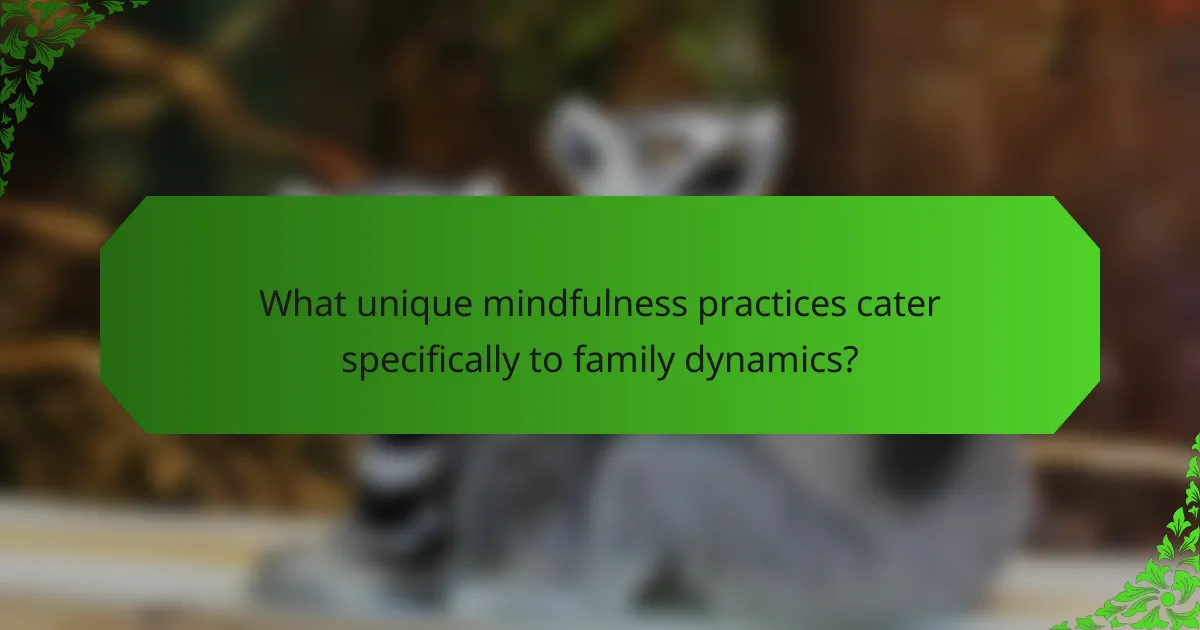
What unique mindfulness practices cater specifically to family dynamics?
Mindfulness practices tailored for family dynamics include activities that foster connection and understanding. Techniques such as family meditation sessions, mindful communication exercises, and gratitude sharing enhance emotional resilience. These unique practices create a supportive environment, promoting stronger bonds and reduced stress. Engaging in nature walks while practicing mindfulness can further deepen family connections.
How can storytelling enhance mindfulness in family settings?
Storytelling enhances mindfulness in family settings by fostering connection and presence. Engaging narratives encourage active listening, creating shared experiences that reduce stress and strengthen emotional bonds. This practice cultivates empathy, allowing family members to understand each other’s feelings better. As a result, storytelling becomes a unique mindfulness activity that promotes emotional resilience within families.
What unique family rituals can incorporate mindfulness?
Mindful family rituals can include daily gratitude sharing, nature walks, and weekly family meetings. These activities enhance emotional resilience and strengthen bonds. For example, a gratitude circle allows each family member to express appreciation, fostering positive communication. Nature walks promote mindfulness through sensory engagement, reducing stress. Weekly meetings provide a platform for discussing feelings and setting family goals, encouraging open dialogue.
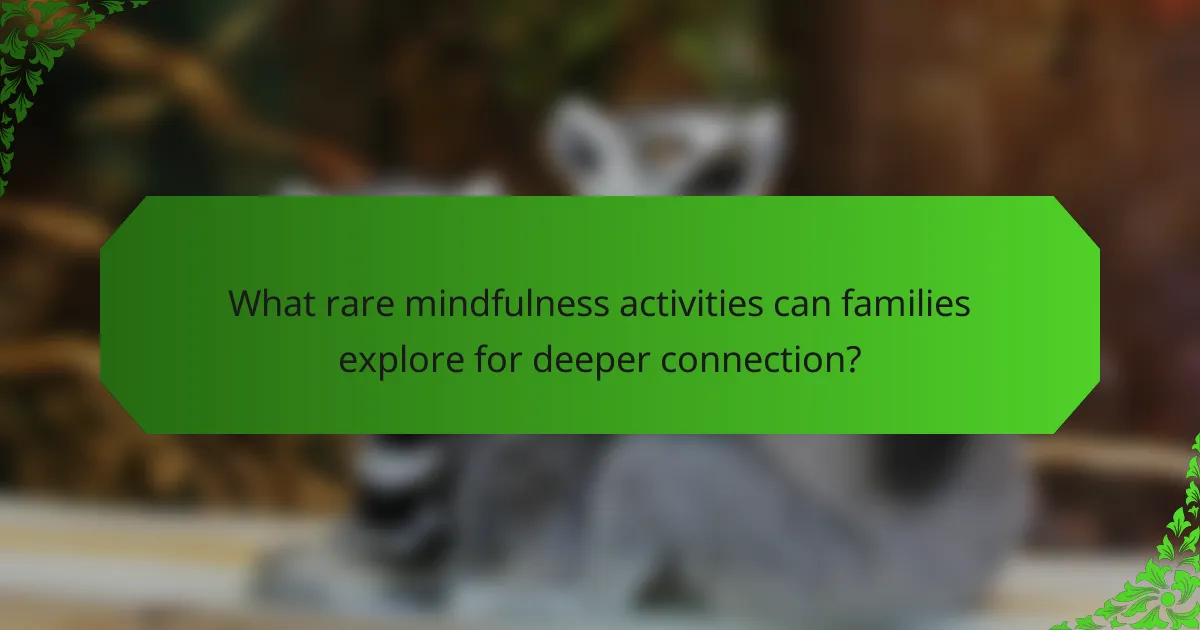
What rare mindfulness activities can families explore for deeper connection?
Families can explore rare mindfulness activities like forest bathing, art therapy, sound meditation, and nature journaling for deeper connection. These activities promote presence, creativity, and emotional sharing.
Forest bathing involves immersing in nature to reduce stress and enhance well-being. Art therapy encourages expression, allowing family members to communicate feelings non-verbally. Sound meditation uses music or nature sounds to foster relaxation and unity. Nature journaling combines observation with creativity, encouraging families to document experiences together.
Engaging in these rare activities can strengthen family bonds while cultivating emotional resilience.
How can nature immersion serve as a mindfulness practice for families?
Nature immersion serves as a powerful mindfulness practice for families by fostering connection, reducing stress, and enhancing emotional resilience. Engaging with nature allows families to share experiences, which strengthens their bonds. Studies show that spending time outdoors can lower cortisol levels, promoting relaxation. Nature encourages present-moment awareness, helping family members to focus on their surroundings and each other. This practice cultivates a unique attribute of emotional resilience, as families learn to navigate challenges together in a calming environment. As a result, nature immersion becomes a holistic approach to mindfulness that benefits family dynamics.
What are the benefits of family gratitude journaling?
Family gratitude journaling enhances emotional connections, promotes positive thinking, and reduces stress. It encourages family members to reflect on shared experiences, fostering appreciation and understanding. Research indicates that practicing gratitude can lead to improved mental health and stronger familial bonds. Regular journaling can also increase resilience, helping families navigate challenges together.
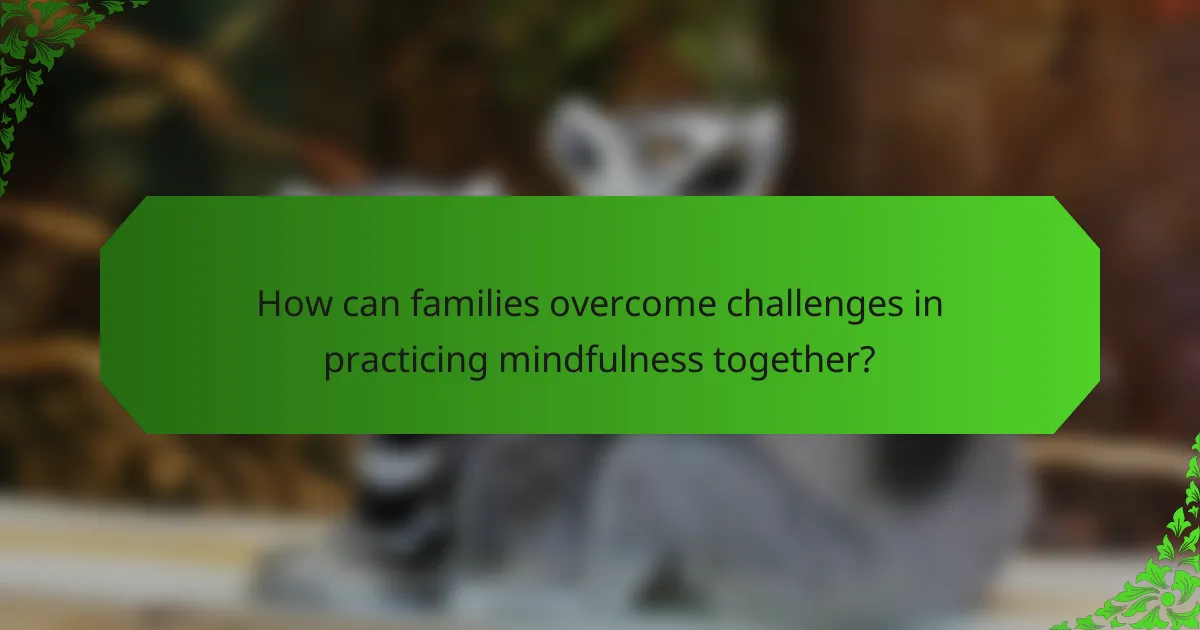
How can families overcome challenges in practicing mindfulness together?
Families can overcome challenges in practicing mindfulness together by establishing a consistent routine, setting clear intentions, and creating a supportive environment. Engaging in activities like guided meditation, mindful eating, or nature walks fosters connection and reduces stress. These practices enhance emotional resilience, allowing families to navigate challenges more effectively. Regularly incorporating mindfulness into family life strengthens bonds and promotes overall well-being.
What common obstacles do families face in mindfulness activities?
Families often face challenges in mindfulness activities, including time constraints, varying interest levels, and distractions. Time constraints can limit opportunities for practice, making it difficult to establish a routine. Varying interest levels among family members can lead to disengagement, reducing the effectiveness of activities. Distractions, such as electronic devices and busy environments, can disrupt focus and mindfulness. Addressing these obstacles requires creativity and flexibility in approach, ensuring that mindfulness activities remain engaging and accessible for all family members.
How can families stay motivated to practice mindfulness regularly?
Families can stay motivated to practice mindfulness regularly by setting specific goals and creating a routine. Establishing a consistent time each day for mindfulness activities strengthens family bonds and enhances emotional resilience.
Incorporating a variety of engaging activities, such as guided meditations, mindful walks, or breathing exercises, keeps the practice fresh and enjoyable. Families can also share their experiences and progress, fostering accountability and support.
Utilizing mindfulness apps or resources designed for families can provide structured guidance and new techniques to explore. Regularly reflecting on the benefits, such as reduced stress and improved communication, reinforces the importance of maintaining these practices.
Lastly, celebrating milestones together, whether small or significant, builds a sense of achievement and encourages continued commitment to mindfulness as a family.
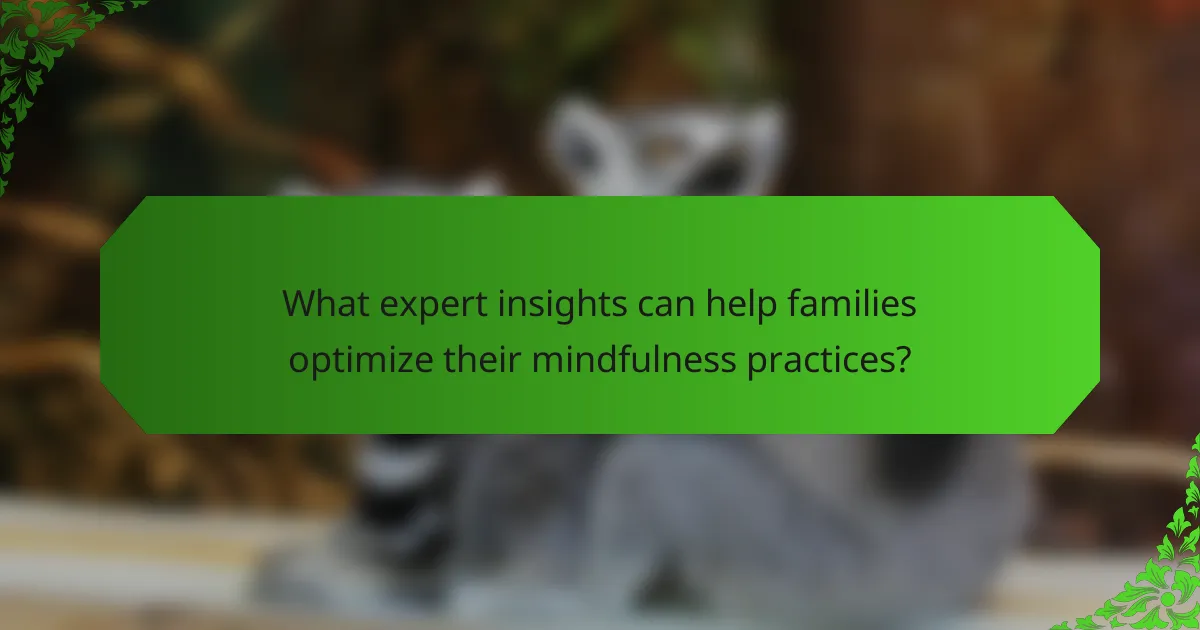
What expert insights can help families optimize their mindfulness practices?
To optimize mindfulness practices, families should incorporate structured activities that enhance connection and emotional resilience. Engaging in regular mindfulness exercises, such as guided meditations or nature walks, fosters deeper family bonds and reduces stress. Research indicates that families practicing mindfulness together report improved communication and emotional regulation. Setting aside dedicated time for mindfulness can lead to a consistent routine, enhancing overall family well-being. Regular reflection on these practices can also help families adapt and grow in their mindfulness journey.
What are the best practices for integrating mindfulness into daily family life?
Integrating mindfulness into daily family life involves consistent practices that foster connection and reduce stress. Start with short family meditation sessions, ideally 5-10 minutes, to cultivate presence. Engage in mindful eating by savoring meals together, enhancing appreciation for food. Incorporate gratitude practices, such as sharing daily highlights, to promote positivity. Schedule regular family walks in nature, allowing for reflection and conversation. Lastly, create a designated mindfulness space at home for activities like yoga or journaling, encouraging a routine focused on emotional resilience.
What mistakes should families avoid in mindfulness activities?
Families should avoid common mistakes in mindfulness activities to enhance their effectiveness. Failing to set a regular schedule can lead to inconsistency, diminishing the benefits of mindfulness. Not creating a distraction-free environment can hinder focus and engagement. Additionally, neglecting to tailor activities to the age and interests of family members may result in disengagement. Overemphasizing perfection can create pressure, detracting from the relaxed nature of mindfulness. Lastly, skipping discussions about experiences can prevent emotional connection and growth.
How can families measure the impact of mindfulness on their wellbeing?
Families can measure the impact of mindfulness on their wellbeing through regular assessments of emotional and physical health. Tracking mood changes, stress levels, and overall family interactions can provide insights into the benefits of mindfulness activities.
Establish a baseline by documenting current family dynamics and stressors. Use tools like journals or apps to record feelings before and after mindfulness sessions. As a result, families may notice improvements in communication, emotional resilience, and reduced anxiety over time.
Engaging in mindfulness activities together fosters a supportive environment. This communal practice strengthens bonds and enhances the overall family experience. Regularly revisiting goals and outcomes can help families adjust their mindfulness practices for maximum benefit.
Data indicates that families practicing mindfulness report a 30% increase in emotional connection and a 25% decrease in stress levels within three months. These measurable changes highlight the unique attributes of mindfulness in promoting family wellbeing.
